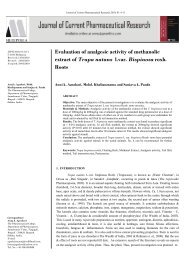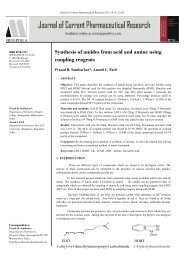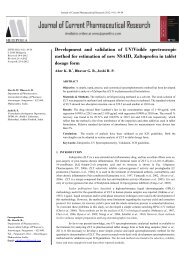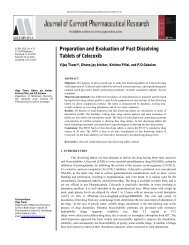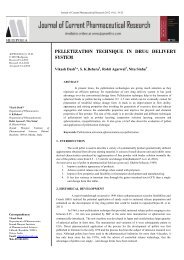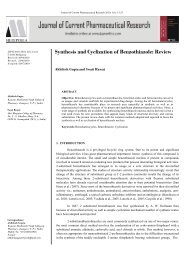Invitro regeneration of acorus Calamus – an important medicinal plant
Invitro regeneration of acorus Calamus – an important medicinal plant
Invitro regeneration of acorus Calamus – an important medicinal plant
Create successful ePaper yourself
Turn your PDF publications into a flip-book with our unique Google optimized e-Paper software.
Journal <strong>of</strong> Current Pharmaceutical Research 2010; 2(1): 36-39Table 1. Effect <strong>of</strong> different concentration <strong>of</strong> IAA <strong>an</strong>d IBA on shoot proliferation <strong>of</strong> Acorus calamus using 1/4 thMS MediaS.N.Concentration(µmol)IAA IBANumber <strong>of</strong>expl<strong>an</strong>tsinoculatedNumber <strong>of</strong>expl<strong>an</strong>tsproliferated% <strong>of</strong> shootformationNumber <strong>of</strong>shoots/expl<strong>an</strong>t1 3.0 2.1 10 2 20 3.52 3.5 2.2 10 3 30 33 4.0 2.4 10 5 50 2.84 4.5 2.4 10 1 10 25 5.0 2.6 10 2 20 26 5.7 2.4 10 9 90 5.6For rooting, well developed shoots were tr<strong>an</strong>sferred on the MSmedium with IBA alone. The shoot proliferation was done on 1/4 thMS medium containing 5.7µmol IAA <strong>an</strong>d 2.4µmol IBA. Data onpercentage <strong>of</strong> expl<strong>an</strong>ts showing shoot proliferation, number <strong>of</strong>shoots per culture was recorded <strong>an</strong>d results obtained are shown in aTable 1. Rooted pl<strong>an</strong>tlets were removed from the culture tube <strong>an</strong>dagar was washed thoroughly with distilled water. The pl<strong>an</strong>tletswere then tr<strong>an</strong>sferred into small plastic bags containings<strong>an</strong>d:soil:compost, pl<strong>an</strong>tlets were watered every two days for twoweeks, in growth chamber(glass house) where they were exposedto high humidity <strong>an</strong>d temperature for two weeks. The pl<strong>an</strong>tletswere finally established in the field for hardening.3. RESULT & DICUSSIONNaturally grown, fresh rhizomes were cut into smallpieces <strong>of</strong> about 1-3cm, were used as expl<strong>an</strong>ts for shoot<strong>regeneration</strong> <strong>an</strong>d multiplication.Regeneration <strong>of</strong> shoot from expl<strong>an</strong>t was observed atdifferent hormone concentrations. The highest percentage <strong>of</strong> shootproliferation was recorded at 1/4thMS+5.7µmol IAA+2.4µmolIBA. Combination <strong>of</strong> IAA <strong>an</strong>d IBA showed better results. Bestrooting was observed with 1mg/L IBA.The root induced pl<strong>an</strong>tletswere successfully tr<strong>an</strong>sferred to hardening after 30 days <strong>an</strong>dPl<strong>an</strong>tlets produced using rootlets were acclimatized <strong>an</strong>dtr<strong>an</strong>spl<strong>an</strong>ted. About 90% <strong>of</strong> the in vitro Micropropagated pl<strong>an</strong>tswere healthy <strong>an</strong>d useful for propagation.4. CONCLUSIONThe sweet flag Acorus calamus rarely produces the seeds<strong>an</strong>d mainly propagated by vegetative me<strong>an</strong>s, it has been reported inthe traditional system <strong>of</strong> medicine for the treatment <strong>of</strong> dyspepsiaflatulence, cough, fever, piles <strong>an</strong>d asthma. From the present studyit was found that combinations <strong>of</strong> IAA <strong>an</strong>d IBA responded bettershoot formation <strong>an</strong>d rooting was found best on MS mediumTable 2. Effect <strong>of</strong> growth regulators on in vitro root <strong>regeneration</strong> on Acorus calamus shootsS.N. Growth regulators Observation after20 daysobservation after30 daysobservation after40 days1 Half strength MS +0.5mg/L NAA2 Half strength MS +0.5 mg/L IBANo growth No growth No growthNo growth No response No response3 Quarter strength MS +5.7µm IAA + 2.4µmIBANo growthbuff colored rootwas formedM<strong>an</strong>yadventitious rootswere formed4 MS + 1mg/L IBA Root formed Increase in theno.<strong>of</strong> roots seenWell developedadventious rootsformed38
Journal <strong>of</strong> Current Pharmaceutical Research 2010; 2(1): 36-39containing 1mg/L IBA alone. So suitable tissue culture techniqueswas established for in vitro shoot proliferation <strong>of</strong> Acorus calamuswhich c<strong>an</strong> be used for the mass production <strong>of</strong> diseases free pl<strong>an</strong>ts,irrespective <strong>of</strong> season <strong>an</strong>d will serve as <strong>an</strong> alternative source <strong>of</strong>seed materials. In vitro preservation <strong>of</strong> germplasm is also safemethod to protect species & reducing the risk <strong>of</strong> natural vagaries.Further estimation <strong>of</strong> secondary constituents from natural <strong>an</strong>d invitro pl<strong>an</strong>ts <strong>an</strong>d <strong>an</strong>timicrobial activity <strong>of</strong> both natural <strong>an</strong>d invitropl<strong>an</strong>ts will be carried out in future.REFERENCESAhmed M.B. et.al, 2007 St<strong>an</strong>dardization <strong>of</strong> a Suitable Protocol for inVitro Clonal Propagation <strong>of</strong> Acorus calamus L. <strong>an</strong> Import<strong>an</strong>t Medicinal Pl<strong>an</strong>tin B<strong>an</strong>gladesh. Am-Euras . J. Sci. Res., 2 (2): 136-140.Kokate CK, Purohit AP <strong>an</strong>d Gokhale SB,2003 In:Pharmacognosy,24 thed.Nirali prakash<strong>an</strong>,pune,pp.379-380.Hettiarachchi A, Fern<strong>an</strong>do KKS <strong>an</strong>d Jayasuriya AHM 1997 <strong>Invitro</strong>propagation <strong>of</strong> Wadakha (Acorus calamus L). J.Natn.sci.coun.Sri L<strong>an</strong>ka25(3):151-157.Raina VK, Srivastava SK, Syamasunder KV. J Flav <strong>an</strong>d frag. 2002;18(1): 18-20.Modhumita, Ghosh. Antifungal properties <strong>of</strong> haem peroxidase fromAcorus calamus. Ann Bot. 2006; 98(6): 1145-5339



